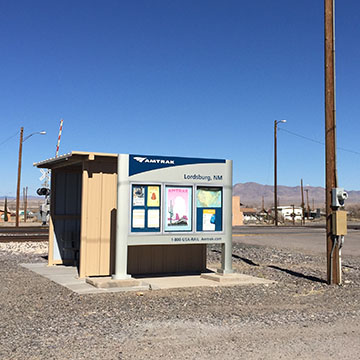Lordsburg, NM (LDB)
Lordsburg is known for its proximity to some of the great natural landscapes of the Southwest, including Gila National Forest and numerous mountain ranges.

Railroad crossing, south side of tracks
Center Street and East Motel Drive
Lordsburg, NM 88045
Annual Station Ridership (FY 2024): 634
- Facility Ownership: N/A
- Parking Lot Ownership: Union Pacific Railroad
- Platform Ownership: N/A
- Track Ownership: Union Pacific Railroad
Alex Khalfin
Regional Contact
governmentaffairsoak@amtrak.com
For information about Amtrak fares and schedules, please visit Amtrak.com or call 1-800-USA-RAIL (1-800-872-7245).
Passengers at Lordsburg use the street at the grade crossing for boarding, and there is also a shelter with benches.
In 1988, the Southern Pacific razed the original 1880s wooden clapboard station that once stood by the tracks. Low slung, it featured a hipped roof and wide eaves supported by numerous simple wooden brackets; the eaves provided much needed shade for passengers and railroad employees, as a warm summer day in town can reach almost 100 degrees.
Lordsburg was founded in 1880 when the Southern Pacific reached the area on its way east in a quest to complete the second transcontinental railroad. Theories abound as to the town’s namesake, but the most reasonable seems to be that it was named in honor of Delbert Lord, chief engineer for the railroad’s mainline, and who located the town site halfway between Tucson and El Paso.
In addition to rail, road transport has also been important to the area. Across from the rail station one could find the Hotel Hidalgo, designed in 1928 by the El Paso architecture and engineering firm of Trost and Trost. Constructed in the Pueblo Revival style so popular in New Mexico, it featured a lobby with an impressive beamed ceiling and plush red leather chairs. The hotel was a well known landmark and stop on the Old Spanish Trail, a transcontinental highway inaugurated in 1915 that eventually connected St. Augustine, FL to San Diego, CA. In the 1960s, new interstate highways bypassed the old roads, and the highway fell into obscurity, hurting establishments such as the Hotel Hidalgo.
Although a small town, Lordsburg has seen its fair share of important historic events. In the late 19th century, the town served as a shipping point for numerous mine communities such as Shakespeare and Steins, which are today ghost-towns. In 1927, Charles Lindbergh stopped in Lordsburg during his cross-country trip; Amelia Earhart would also visit the town’s airport, the first in New Mexico. During World War II, Lordsburg became known as the site of an internment camp for Japanese-Americans operated by the U.S. Army.
Today Lordsburg is known for its proximity to some of the great natural landscapes of the Southwest, including Gila National Forest, as well as numerous mountain ranges that provide opportunities for hiking, hunting, and bird watching. Appropriately, New Mexico’s state song, which praises “Rugged and high sierras, With deep canyons below, Dotted with fertile valleys…” was written by Elizabeth Garrett while she resided in Lordsburg in the early 20th century.
Platform with Shelter
Features
- ATM not available
- No elevator
- No payphones
- No Quik-Trak kiosks
- No Restrooms
- Unaccompanied child travel not allowed
- No vending machines
- No WiFi
- Arrive at least 30 minutes prior to departure
Baggage
- Amtrak Express shipping not available
- No checked baggage service
- No checked baggage storage
- Bike boxes not available
- No baggage carts
- Ski bags not available
- No bag storage
- Shipping boxes not available
- No baggage assistance
Parking
- Same-day parking is available for free
- Overnight parking is available for free
Accessibility
- No payphones
- Accessible platform
- No accessible restrooms
- No accessible ticket office
- No accessible waiting room
- No accessible water fountain
- Same-day, accessible parking is available for free
- Overnight, accessible parking is available for free
- No high platform
- No wheelchair
- Wheelchair lift available
Hours


 Amtrak established the Great American Stations Project in 2006 to educate communities on the benefits of redeveloping train stations, offer tools to community leaders to preserve their stations, and provide the appropriate Amtrak resources.
Amtrak established the Great American Stations Project in 2006 to educate communities on the benefits of redeveloping train stations, offer tools to community leaders to preserve their stations, and provide the appropriate Amtrak resources. Amtrak is seizing a once-in-a-lifetime opportunity to transform rail and Retrain Travel. By modernizing, enhancing and expanding trains, stations and infrastructure, Amtrak is meeting the rising demand for train travel. Amtrak offers unforgettable experiences to more than 500 destinations across 46 states and parts of Canada. Learn more at
Amtrak is seizing a once-in-a-lifetime opportunity to transform rail and Retrain Travel. By modernizing, enhancing and expanding trains, stations and infrastructure, Amtrak is meeting the rising demand for train travel. Amtrak offers unforgettable experiences to more than 500 destinations across 46 states and parts of Canada. Learn more at